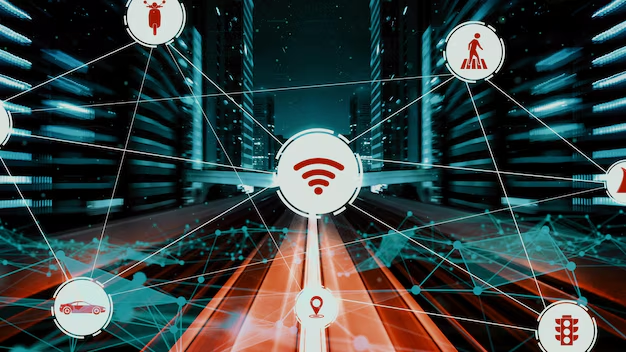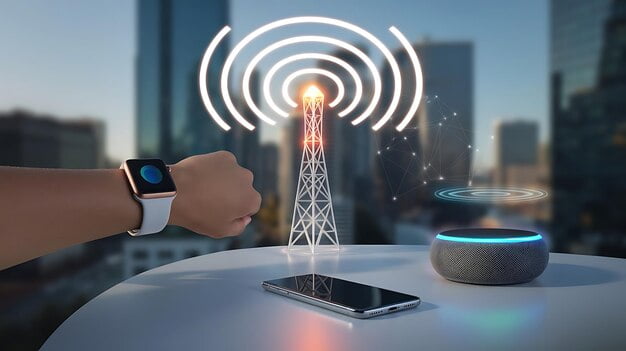Wireless networks have become the backbone of modern communication, shaping the way we connect, share information and interact with the world. From the early days of basic voice calls to today’s ultra-fast, data-rich environments, wireless technology has undergone a remarkable evolution. Each new generation of network standards—starting from 1G and leading up to the anticipated arrival of 6G—has introduced groundbreaking advancements, transforming both personal and professional communication.
This blog will take you through the journey of wireless network standards, highlighting the key milestones from the analog systems of 1G to the upcoming possibilities with 6G. By understanding this evolution, we can appreciate how far we’ve come and what the future holds for wireless communication in an increasingly connected world.

1G: The Dawn of Wireless Communication
The journey of wireless networks began in the 1980s with the introduction of 1G or the first generation of cellular networks. Marking a significant leap from landline telephony, 1G brought the first mobile phones to life, allowing people to make voice calls without being tethered to a physical line. However, it was rudimentary by today’s standards, operating on analog signals rather than digital, which meant lower quality and security.
1G networks were primarily built on Frequency Division Multiple Access (FDMA) technology, enabling voice communication over radio frequencies. While this allowed mobile communication to be more accessible, 1G systems came with several limitations:
- Limited coverage and capacity: Network infrastructures were still in their infancy, and connectivity was often poor, especially in rural or densely populated areas.
- Low sound quality: The analog signal was prone to interference and noise, resulting in inconsistent voice quality during calls.
- Lack of data services: 1G was voice-only, with no capacity for transmitting data like text messages or internet access.
Another significant drawback was security. Since 1G networks lacked encryption, they were vulnerable to eavesdropping, and conversations could easily be intercepted. Despite these limitations, 1G was a pivotal step forward, enabling mobile communication for the first time and setting the stage for the more advanced generations to come.
The most notable 1G system was the Advanced Mobile Phone System (AMPS), which was widely adopted in the United States. Other countries developed their versions, but the core principle remained the same: a revolution in mobile telephony, though still far from what we know today.
This first generation laid the groundwork for future innovations, and as user demand for better sound quality, wider coverage, and data transmission grew, it became clear that a shift to digital networks was needed—leading to the birth of 2G.
2G: The Era of Digital Communication
With the limitations of 1G becoming apparent, the 1990s witnessed the arrival of 2G, or the second generation of wireless networks, which marked a breakthrough in mobile communication technology. Unlike its analog predecessor, 2G introduced digital communication, revolutionizing how people used mobile phones and laying the foundation for many of the features we now take for granted.
One of the key innovations of 2G was the introduction of Global System for Mobile Communications (GSM), a digital cellular technology that became the standard in most parts of the world. The shift from analog to digital brought several advantages:
- Improved voice quality: Digital signals were clearer and less prone to interference, significantly enhancing the user experience during voice calls.
- Enhanced security: Digital encryption ensured that conversations were more secure and protected from eavesdropping, addressing one of the major flaws of 1G.
- Increased network capacity: Digital networks allowed for more efficient use of the available spectrum, enabling more users to connect simultaneously without degrading service quality.
However, perhaps the most revolutionary aspect of 2G was the introduction of data services. For the first time, users could send Short Message Service (SMS), also known as text messages, as well as Multimedia Messaging Service (MMS), which allowed for the sharing of images and sounds. This fundamentally changed how people communicated, moving beyond voice calls to text-based interactions.
Alongside GSM, 2G saw the development of Code Division Multiple Access (CDMA), an alternative digital technology widely adopted in the United States and parts of Asia. Both GSM and CDMA brought notable advancements, though GSM remained the dominant global standard.
2G also marked the beginning of mobile internet access, though it was still quite slow compared to modern standards. With technologies like General Packet Radio Service (GPRS) and Enhanced Data Rates for GSM Evolution (EDGE), 2G networks allowed for basic internet browsing, email access, and early mobile applications.
The rise of 2G brought mobile phones into mainstream use, making them more affordable and accessible to a global audience. The ability to send text messages, combined with better call quality and security, sparked a mobile communication revolution. By the late 1990s, the growing demand for even faster data speeds and richer multimedia services paved the way for the next leap forward: 3G.
3G: The Birth of Mobile Internet
As the demand for faster data speeds and enhanced mobile services grew, the early 2000s brought the advent of 3G, or the third generation of wireless networks. While previous generations were primarily focused on voice communication, 3G marked the beginning of a new era by introducing mobile internet. This breakthrough allowed users to access the web, download apps, and stream multimedia content on their mobile devices for the first time, transforming the role of mobile phones from simple communication tools to all-in-one digital devices.
One of the defining features of 3G was its support for high-speed data transmission, thanks to technologies like Universal Mobile Telecommunications System (UMTS) and Wideband Code Division Multiple Access (WCDMA). These advancements enabled data transfer rates up to 2 Mbps, which was a significant improvement over the slow, basic browsing capabilities of 2G. This new bandwidth allowed users to engage in a wide range of online activities:
- Web browsing: With faster data speeds, mobile internet access became more practical, allowing users to browse websites on the go.
- Video calling: 3G enabled real-time video calls, making face-to-face communication possible over mobile networks for the first time.
- Email and multimedia: Downloading attachments, viewing images, and streaming audio and video content became accessible on mobile devices.
- Mobile apps: The rise of 3G coincided with the development of the first mobile applications, fueling the growth of app ecosystems like Apple’s App Store and Google Play.
The introduction of HSPA (High-Speed Packet Access) further boosted 3G performance, providing download speeds of up to 14 Mbps. This upgrade significantly enhanced the user experience, particularly for streaming services, video conferencing, and downloading larger files.
The arrival of 3G also marked a turning point for industries and businesses. It allowed for mobile e-commerce, cloud-based services, and remote work, changing the way companies operated. The improved connectivity of 3G was crucial for early IoT (Internet of Things) devices, laying the groundwork for connected homes, smart cities, and industrial applications that relied on wireless communication.
While 3G networks provided a massive leap in functionality compared to 2G, they eventually began to show limitations as mobile data consumption soared. Video streaming, mobile gaming, and other data-intensive applications quickly outgrew 3G’s capabilities, leading to the development of the next leap in wireless technology: 4G.
4G: Revolutionizing High-Speed Connectivity
As mobile devices became central to daily life, the need for even faster and more reliable connectivity led to the introduction of 4G (fourth-generation) networks. Launched in the late 2000s, 4G revolutionized the mobile internet experience by delivering unprecedented speed and low latency, fundamentally changing how people used their smartphones and other devices. This leap forward enabled high-definition streaming, seamless video conferencing, and real-time gaming, making mobile connectivity feel as fast and responsive as traditional broadband.
The key innovation behind 4G was Long-Term Evolution (LTE) technology, which dramatically improved data transfer rates, offering speeds up to 100 Mbps or more in some cases. Compared to the 3G network, 4G provided a vastly superior mobile experience:
- High-speed internet: With faster download and upload speeds, users can stream high-definition videos, download large files, and browse the internet without lag.
- Improved video calling: Video calls became clearer and smoother, with less buffering or dropped connections.
- Mobile apps and cloud services: The enhanced bandwidth allowed for the growth of data-heavy applications like social media, on-demand services, and cloud-based productivity tools.
- Online gaming: 4G made it possible to play multiplayer games in real-time on mobile devices without the lag and latency issues of previous generations.
The expansion of LTE-Advanced technology further enhanced the performance of 4G networks. By using carrier aggregation—the ability to combine multiple frequency bands—LTE-Advanced delivered even faster speeds and improved network capacity, making it easier for operators to manage growing user demand. This allowed more devices to connect simultaneously without sacrificing speed or quality, an important feature as mobile data usage skyrocketed.
4G also brought significant improvements in VoIP (Voice over IP), leading to the rise of services like Voice over LTE (VoLTE). VoLTE allowed for high-definition voice calls over data networks, improving call quality and reliability while using the same infrastructure for both voice and data.
The impact of 4G on industries and society was profound. With the rise of streaming services like Netflix and Spotify, users could consume media on the go without waiting for downloads or suffering from buffering. Social media platforms grew exponentially as users could upload videos, photos, and live stream content with ease. Additionally, mobile e-commerce surged as businesses took advantage of faster, more reliable connections to offer consumers a seamless shopping experience.
4G networks also played a critical role in enabling smart cities and IoT (Internet of Things) applications, supporting everything from connected vehicles and infrastructure to home automation and wearable technology.
However, as digital services continued to evolve and data consumption skyrocketed, even the enhanced capabilities of 4G began to face limitations. This growing demand for ultra-fast, low-latency communication laid the groundwork for the next-generation wireless technology: 5G.
5G: The Foundation of a Connected World
As digital connectivity became increasingly embedded in everyday life, the arrival of 5G marked a new era in wireless communication. Launched in the late 2010s, 5G—fifth generation—set the stage for a fully connected world, where everything from smartphones to smart cities and autonomous vehicles can communicate seamlessly. Offering unprecedented speeds, ultra-low latency, and massive network capacity, 5G is more than just an evolution of previous generations; it represents a fundamental shift in how wireless networks operate.
At the heart of 5G is its promise to deliver data speeds up to 100 times faster than 4G, reaching up to 10 Gbps in some cases. This level of performance opens the door to transformative technologies and services, making 5G the backbone of innovations like autonomous vehicles, smart factories, and immersive virtual reality experiences. The key technologies driving 5G’s capabilities include:
- Millimeter-wave (mmWave) spectrum: This high-frequency spectrum allows for incredible data speeds, though its range is shorter compared to lower frequencies.
- Massive MIMO (Multiple Input Multiple Output): A technology that enables the network to handle more devices at once by using multiple antennas to send and receive signals.
- Network slicing: This feature allows operators to create dedicated “slices” of the network tailored to specific use cases, ensuring performance can be optimized for different services (e.g., autonomous cars versus smart homes).
One of the standout features of 5G is its ultra-low latency, with response times reduced to as low as 1 millisecond. This real-time responsiveness is critical for applications such as:
- Autonomous driving: Self-driving vehicles rely on immediate communication with other cars, traffic signals, and road infrastructure to make split-second decisions.
- Remote surgery: Surgeons can operate on patients from different locations with precision, thanks to 5G’s ability to deliver high-definition video and tactile feedback in real time.
- Augmented and virtual reality: 5G enhances the user experience in AR/VR environments by eliminating lag, and making interactions feel more natural and immersive.
Beyond speed and latency, 5G also brings enhanced network capacity, enabling it to connect billions of devices simultaneously. This is essential for the continued growth of the Internet of Things (IoT), where devices like smart home appliances, industrial sensors, and wearables all require constant, reliable connectivity. With 5G, smart cities can function more efficiently by integrating traffic management systems, energy grids, and public safety infrastructure into a unified, intelligent network.
5G’s impact extends far beyond consumer applications. Industry 4.0, the next phase of industrial automation, relies heavily on 5G to enable smart manufacturing, where machines, robots, and supply chains are interconnected, operating autonomously based on real-time data analytics. Healthcare, agriculture, and logistics are also set to benefit from 5G’s capabilities, enabling remote patient monitoring, precision farming, and more efficient global supply chains.
However, deploying 5G at scale comes with challenges, particularly in terms of infrastructure. The use of higher-frequency bands requires a dense network of small cells—smaller base stations placed closer together to maintain consistent coverage. This means that urban areas will likely see 5G first, while rural regions may experience slower adoption due to the costs of infrastructure expansion.
Despite these challenges, 5G represents the future of connectivity, powering everything from smart homes to connected vehicles and AI-driven industries. As the world becomes more interconnected, 5G serves as the foundation for a hyper-connected digital ecosystem, enabling innovations that will reshape how we live, work, and interact. As we look ahead, the groundwork laid by 5G paves the way for the next frontier: 6G, promising even more transformative possibilities in the future.

6G: The Future of Wireless Networking
While 5G is still in the process of widespread adoption, the development of 6G is already underway, promising to push the boundaries of wireless communication even further. Expected to arrive in the early 2030s, 6G represents the next leap in wireless networking technology, offering speeds up to 100 times faster than 5G, with data rates reaching up to 1 terabit per second (Tbps). Beyond sheer speed, 6G will redefine connectivity by integrating cutting-edge technologies like artificial intelligence (AI), quantum computing, and holographic communication, enabling a new wave of innovation.
At the core of 6G’s potential is its ability to leverage the terahertz (THz) frequency spectrum, which lies between the microwave and infrared spectrums. This will enable incredibly high-speed data transmission, supporting use cases that require vast amounts of data to be processed and transferred in real-time. Some of the key advancements expected with 6G include:
- Holographic communication: Moving beyond traditional voice and video calls, 6G will enable fully immersive, 3D holographic communications, revolutionizing telepresence and remote collaboration.
- Integrated AI: AI will be deeply embedded within 6G networks, allowing for intelligent, self-optimizing systems that can dynamically allocate resources and improve network performance without human intervention.
- Quantum communication: 6G may incorporate quantum encryption for enhanced data security and quantum computing to solve complex problems at unprecedented speeds, pushing the limits of what wireless networks can achieve.
6G will also bring extremely low latency, with response times as low as sub-millisecond levels, making real-time interactions virtually instantaneous. This will unlock new possibilities in areas such as:
- Tactile Internet: By delivering real-time feedback and interaction, 6G could enable remote physical interactions in fields like surgery, manufacturing, and education.
- Extended reality (XR): 6G will support more immersive virtual reality (VR) and augmented reality (AR) experiences, with no perceptible lag, allowing users to seamlessly blend the physical and digital worlds.
- Autonomous systems: Autonomous vehicles, drones, and robotics will benefit from the enhanced connectivity of 6G, allowing for safer, more efficient operations in complex environments.
A critical aspect of 6G is its ability to support hyper-connected environments, where billions of devices—from wearables and smart appliances to connected infrastructure—will be seamlessly integrated into a unified network. This will enable ubiquitous connectivity, where everything, including people, devices, and environments, is continuously connected and exchanging information. In this vision, smart cities, smart healthcare, and smart industries will operate at levels of efficiency and intelligence that were previously unimaginable.
Moreover, 6G is expected to play a pivotal role in addressing some of the world’s most pressing challenges, such as climate change, global healthcare, and sustainable development. By enabling remote work and education on a global scale, optimizing energy consumption through smart systems, and improving disaster response through real-time data sharing, 6G has the potential to make a profound impact on both the economy and society.
However, the road to 6G will not be without challenges. The deployment of 6G will require significant advancements in infrastructure, as the higher frequencies used by 6G will necessitate an even denser network of base stations and small cells than 5G. Additionally, integrating AI and quantum technologies into wireless networks will require new standards, protocols, and a rethinking of data security and privacy.
As research and development into 6G progresses, the vision of a fully connected, intelligent world is starting to take shape. While 5G is still unlocking its potential, 6G promises to push the frontiers of wireless communication and transform the way we interact with technology, paving the way for a future where digital and physical realities merge seamlessly.

Conclusion
The evolution of wireless networking, from 1G to 6G, reflects a remarkable journey of technological advancement and innovation. Each generation has brought significant improvements in speed, connectivity, and capabilities, transforming how we communicate, work, and interact with the world.
1G laid the foundation for mobile communication with its analog technology, primarily enabling voice calls. 2G introduced digital technology, enhancing voice quality and adding features like text messaging, setting the stage for the digital communication era. 3G marked the beginning of mobile internet, allowing users to browse the web and stream multimedia content, thus making mobile devices indispensable for accessing online services.
With 4G, the focus shifted to delivering high-speed internet, enabling high-definition streaming, real-time gaming, and seamless video calls. The advent of 5G brought an unprecedented leap in performance with ultra-fast speeds, ultra-low latency, and massive connectivity, paving the way for innovations such as autonomous vehicles, smart cities, and immersive virtual experiences.
As we look forward to 6G, the horizon is filled with possibilities that promise to redefine the very fabric of connectivity. With anticipated advancements like terahertz communication, AI-driven networks, and holographic communication, 6G will enable a truly connected world where digital and physical realities merge seamlessly. The promise of 6G extends beyond mere speed, offering transformative capabilities that will drive the next wave of innovation across various domains, from remote surgery to smart infrastructure.
Each generation of wireless technology has built upon the achievements of its predecessors, continually pushing the boundaries of what is possible. As we stand on the cusp of the 6G era, it is clear that the future of wireless networking will be characterized by unprecedented levels of connectivity, intelligence, and integration, shaping a new digital landscape that will profoundly impact every aspect of our lives.
The journey from 1G to 6G highlights not only the rapid pace of technological advancement but also the profound ways in which these innovations have transformed our world. As we continue to embrace and build upon these advancements, the future of wireless networking promises to be an exciting frontier of limitless possibilities, driven by the relentless pursuit of progress and connectivity.












